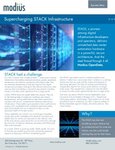Across organizations and IT leaders everywhere, the benefits of cloud computing are widely recognized. Cloud usage has proliferated over the past decade, particularly in the last three years, as the need to modernize IT quickly to enable remote working drove many organizations to invest.
But, while many workloads are very well served in the cloud, organizations are finding that some requirements, such as storage, can be better off in their own data center. This perhaps helps explain why IDC research shows that there's now a 50/50 split between the use of public cloud and on-premises infrastructure for storage workloads.
Elsewhere, other interesting trends are emerging, including that enterprise users are favoring hybrid approaches ahead of 'all-in' or 'cloud-first' strategies.
As well as embracing a blend of on-premises and public cloud, the use of multi-cloud is also building momentum, whereby organizations partner with multiple providers depending on their specific needs.
In this context, it's also clear that many IT leaders remain open-minded to the possibilities and benefits of each option, including cloud repatriation, whereby workloads are taken off the public cloud and hosted locally.
Understanding the drive toward having both
The factors that influence whether to repatriate some workloads to on-premises environments offer some interesting insight into the thinking of IT decision-makers.
When public cloud first came to prominence, issues such as cost control, elasticity, and flexibility were major driving factors. Fast forward to today, and while the public cloud's ability to quickly scale resources remains compelling, experience has also taught enterprise users that they often need to dedicate time and resources to administer their public cloud infrastructure.
In addition, the cost savings initially associated with the public cloud don't always materialize, particularly given the potential for overspending or the potentially high cost of data egress.
In fact, Ofcom recently proposed to refer the cloud industry to the Competition and Markets Authority for further investigation – data egress fees being among the issues raising concern.
Add to this the current challenging and uncertain economic environment, and IT leaders are under pressure to control costs. In these circumstances, some believe the answer lies in greater use of on-premises infrastructure.
But how does this play out in practice? Consider, for example, an organization that stores data in a public cloud archival storage service. In this scenario, it has moved primary data to the public cloud for cost reasons or has decided to keep a backup copy there to use for disaster recovery (DR) purposes.
In either case, the organization doesn't necessarily know if or when it needs to access that data, but the potential situations could include retrieving a copy for DR testing or if there is a need to modify or iterate on an archived original data set to meet a new requirement.
Here's where the data egress issue can cause problems, not only because it's expensive but also because these circumstances can be difficult to predict and budget for.
Organizations that have experienced something like this may use it as a reason to reconsider their approach and the role played by on-premises storage tech.
Emerging strategies for a balanced approach
This is where hybrid and multi-cloud strategies are really coming into their own, particularly for enterprises that want to quickly and seamlessly port applications and workloads between clouds.
In addition, many storage vendors have brought cloud-like innovation to their offerings, emphasizing ease of use and flexibility for users who want to increase or reduce performance and capacity quickly. This service-oriented approach allows organizations to realize some of the key benefits of the public cloud without the downsides.
The 'cloud also' concept is gaining real traction in the search for more resilient, subscription-based, and automated storage solutions.
Looking ahead, it's likely that decisions about which storage technologies and services to use will be driven by deciding which workloads are best suited to on-premises infrastructure and which should reside in the cloud.
Organizations that take this balanced approach will be ideally placed to benefit from the best of both worlds.








